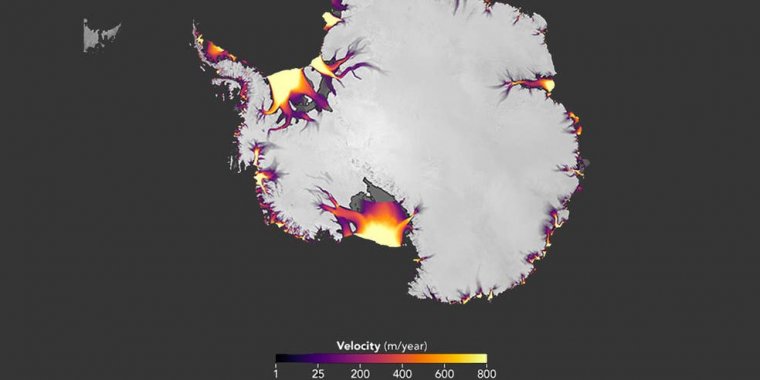| News / Science News |
New Study Brings Antarctic Ice Loss Into Sharper Focus
A NASA study based on an innovative technique for crunching torrents of satellite data provides the clearest picture yet of changes in Antarctic ice flow into the ocean. The findings confirm accelerating ice losses from the West Antarctic Ice Sheet and reveal surprisingly steady rates of flow from its much larger neighbor to the east.

The flow of Antarctic ice, derived from feature tracking of Landsat imagery. Image credits: NASA Earth Observatory
The computer-vision technique crunched data from hundreds of thousands of NASA-U.S. Geological Survey Landsat satellite images to produce a high-precision picture of changes in ice-sheet motion.
The innovative approach by Alex Gardner of NASA’s Jet Propulsion Laboratory in Pasadena, California and his international team of scientists largely confirms earlier findings, though with a few unexpected twists.
Among the most significant: a previously unmeasured acceleration of glacier flow into Antarctica’s Getz Ice Shelf, on the southwestern part of the continent -- likely a result of ice-shelf thinning.
The research also identified the fastest speed-up of Antarctic glaciers during the seven-year study period. The glaciers feeding Marguerite Bay, on the western Antarctic Peninsula, increased their rate of flow by 1,300 to 2,600 feet (400 to 800 meters) per year, probably in response to ocean warming.
Perhaps the research team’s biggest discovery, however, was the steady flow of the East Antarctic Ice Sheet. During the study period, from 2008 to 2015, the sheet had essentially no change in its rate of ice discharge -- ice flow into the ocean.
While previous research inferred a high level of stability for the ice sheet based on measurements of volume and gravitational change, the lack of any significant change in ice discharge had never been measured directly.
The study also confirmed that the flow of West Antarctica’s Thwaites and Pine Island glaciers into the ocean continues to accelerate, though the rate of acceleration is slowing.
In all, the study found an overall ice discharge for the Antarctic continent of 1,929 gigatons per year in 2015, with an uncertainty of plus or minus 40 gigatons. That represents an increase of 36 gigatons per year, plus or minus 15, since 2008. A gigaton is one billion tons.
The study found that ice flow from West Antarctica -- the Amundsen Sea sector, the Getz Ice Shelf and Marguerite Bay on the western Antarctic Peninsula -- accounted for 89 percent of the increase. (NASA)
YOU MAY ALSO LIKE




